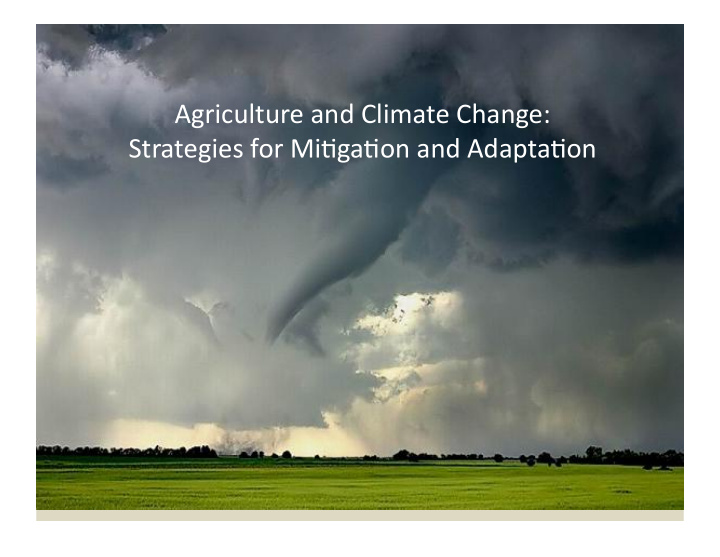



Agriculture ¡and ¡Climate ¡Change: ¡ ¡ Strategies ¡for ¡Mi7ga7on ¡and ¡Adapta7on ¡
What ¡we ¡know ¡ Atmospheric ¡nitrous ¡oxide ¡ methane ¡
Globally ¡……… ¡ Observed ¡ ¡ Modeling ¡ ¡ (20th ¡century) (21st ¡century) Higher ¡maximum ¡temps ¡ Very ¡likely ¡ Very ¡likely ¡ More ¡hot ¡summer ¡days ¡ Likely ¡ Very ¡Likely ¡ Higher ¡minimum ¡temps ¡ Virtually ¡certain ¡ Very ¡Likely ¡ Fewer ¡frost ¡days ¡ Virtually ¡certain ¡ Likely ¡ More ¡heavy ¡1-‑day ¡precip ¡ Likely ¡ Very ¡Likely ¡ More ¡heat ¡waves ¡ Possible ¡ Very ¡Likely ¡ Fewer ¡cold ¡waves ¡ Very ¡likely ¡ Very ¡likely ¡ More ¡drought ¡ Unlikely ¡ Very ¡Likely ¡ More ¡wet ¡spells ¡ Likely ¡ Likely ¡ More ¡intense ¡El ¡Nino ¡events ¡ Possible ¡ Possible ¡ More ¡common ¡El ¡Nino ¡events ¡ Likely ¡ Likely ¡ Easterling ¡et ¡al. ¡Science ¡289:2068-‑2074. ¡
Regionally ¡….. ¡ • Increasing ¡temperatures, ¡par7cularly ¡ nighZme ¡minima ¡ • Precipita7on ¡increasing ¡ • Increasing ¡incidence ¡of ¡high ¡dew ¡points ¡ • Extreme ¡rain ¡events ¡– ¡more ¡frequent ¡than ¡ early ¡20 th ¡century, ¡but ¡comparable ¡to ¡late ¡19 th ¡ century. ¡ For ¡an ¡extended ¡discussion ¡of ¡observed ¡regional ¡climate ¡trends ¡see ¡ ¡ h]p://climate.umn.edu/climateChange/climateChangeObservedNu.htm ¡
Soil ¡Temperatures, ¡St. ¡Paul ¡ ¡ J.M. ¡Baker ¡& ¡D.G. ¡Baker. ¡2002. ¡Clima7c ¡Change ¡54:295-‑303. ¡
Annual ¡Precipita7on, ¡Root ¡River ¡Basin ¡ 1200 ¡ 1100 ¡ 1000 ¡ basin ¡average ¡precip, ¡mm ¡ 900 ¡ 800 ¡ 700 ¡ 600 ¡ 500 ¡ 400 ¡ 1880 ¡ 1900 ¡ 1920 ¡ 1940 ¡ 1960 ¡ 1980 ¡ 2000 ¡ 2020 ¡
Stream ¡Flow, ¡Upper ¡Mississippi ¡at ¡McGregor, ¡IA ¡ 350 ¡ 300 ¡ 250 ¡ 200 ¡ 150 ¡ 100 ¡ 50 ¡ 0 ¡ 1930 ¡ 1940 ¡ 1950 ¡ 1960 ¡ 1970 ¡ 1980 ¡ 1990 ¡ 2000 ¡ 2010 ¡ 2020 ¡
So, ¡higher ¡CO 2 , ¡more ¡precipita7on, ¡warmer ¡temperatures, ¡longer ¡ growing ¡season…. ¡ Why ¡is ¡this ¡a ¡problem ¡for ¡Minnesota ¡agriculture? ¡
Disease ¡and ¡Insect ¡Pressures? ¡ • Higher ¡dew ¡points ¡ • Warmer ¡night ¡7me ¡temperatures ¡ • Shorter, ¡warmer ¡winters ¡
Weeds ¡ • “ ¡Among ¡invasive ¡species ¡however, ¡the ¡response ¡ to ¡recent ¡increase ¡in ¡atmospheric ¡carbon ¡dioxide ¡ is ¡striking, ¡rising ¡by ¡almost ¡90% ¡on ¡average, ¡with ¡ field ¡bindweed, ¡Canada ¡thistle ¡and ¡perennial ¡ sowthistle ¡showing ¡strong ¡responses ¡(Table ¡2). ¡ Although ¡only ¡a ¡limited ¡number ¡of ¡studies ¡ involving ¡the ¡response ¡to ¡recent ¡[CO2] ¡increases ¡ are ¡available, ¡the ¡response ¡of ¡noxious ¡invasive ¡ species ¡is ¡about ¡three ¡7mes ¡that ¡of ¡the ¡reported ¡ average ¡for ¡other ¡plant ¡species ¡over ¡this ¡range ¡of ¡ CO2 ¡concentra7ons.” ¡ L.H. ¡Ziska ¡& ¡K. ¡George. ¡2004. ¡World ¡Resour. ¡Rev. ¡16:428-‑447 ¡
Likely ¡impacts ¡on ¡agriculture ¡ • Li]le ¡change ¡in ¡ET ¡ ¡Water ¡Use ¡Efficiency ¡ probable ¡ ¡in ¡yields ¡due ¡to ¡longer ¡growing ¡season ¡& ¡ CO2 ¡ ¡threat ¡of ¡flooding ¡ ¡heat ¡stress ¡on ¡animals ¡(and ¡humans) ¡due ¡to ¡ ¡ temps, ¡ ¡dew ¡points ¡ disease ¡pressure, ¡maybe ¡ ¡ weed ¡pressure ¡ ¡threat ¡of ¡erosion ¡ threat ¡to ¡water ¡quality ¡( ¡precip, ¡ ¡runoff, ¡ ¡soil ¡ respira7on) ¡
Adapta7on/Mi7ga7on ¡Strategies: ¡ factors ¡to ¡consider ¡ • Essen7ally ¡all ¡farming ¡takes ¡place ¡on ¡private ¡ property ¡ • In ¡the ¡current ¡economic ¡and ¡poli7cal ¡climate, ¡ public ¡funds ¡will ¡be ¡scarce ¡ • Time ¡is ¡of ¡the ¡essence ¡ ¡
Mi7ga7on ¡-‑Carbon ¡Sequestra7on ¡ ¡ Ecosystem ¡ Range ¡of ¡CO 2 ¡Sequestra;on ¡Rates ¡ (metric ¡tons ¡C/acre/yr) ¡ Cropland ¡ 0.2 ¡to ¡0.6 ¡ ¡ ¡ ¡[0.5] ¡ Grassland ¡/ ¡Prairie ¡ 0.1 ¡to ¡1.0 ¡ ¡ ¡ ¡ ¡[0.8] ¡ Forest ¡ 0.05 ¡ ¡to ¡4.0 ¡ ¡[1.2] ¡ Swamp ¡/ ¡Floodplain ¡/ ¡Wetland ¡ 2.2 ¡to ¡3.7 ¡ ¡ ¡ ¡ ¡[3.0] ¡ In ¡agricultural ¡systems ¡the ¡rates ¡are ¡not ¡large, ¡and ¡are ¡difficult ¡to ¡verify. ¡
Mi7ga7on ¡-‑ ¡Sustainable ¡Displacement ¡ of ¡Fossil ¡Fuels ¡ • Pyrolysis, ¡methane ¡genera7on, ¡…(not ¡just ¡ liquid ¡fuels) ¡ • Emphasize ¡products ¡and ¡processes ¡that ¡ complement ¡rather ¡than ¡compete ¡with ¡food ¡ produc7on ¡ • Sustainable ¡both ¡economically ¡and ¡ environmentally ¡
Biochar ¡ Solid ¡residue ¡remaining ¡ater ¡the ¡hea7ng ¡ of ¡organic ¡materials ¡without ¡oxygen ¡ ¡ Pyrolysis ¡ Recalcitrant ¡ carbon ¡ form ¡ Energy ¡ (charcoal) ¡ (>50 ¡to ¡1,000,000 ¡yrs?) ¡ Easily ¡degradable ¡(0-‑5 ¡yrs) ¡
Mi7ga7on-‑Increase ¡N ¡Use ¡Efficiency ¡ = ¡ In ¡terms ¡of ¡global ¡warming ¡poten7al, ¡1 ¡N 2 O ¡molecule ¡= ¡300 ¡CO 2 ¡molecules ¡
N 2 O ¡ Excessive ¡or ¡un7mely ¡fer7lizer ¡applica7on ¡ NO 3 ¡
Adapta7on ¡-‑Increase ¡landscape ¡water ¡storage ¡capacity ¡
Adapta7on-‑ ¡Diversify ¡the ¡landscape ¡ • Increases ¡resilience ¡ • Lessens ¡the ¡likelihood ¡and ¡severity ¡of ¡disease ¡ and ¡pest ¡outbreaks ¡ • Slows ¡the ¡development ¡of ¡resistant ¡pathogens ¡ and ¡weeds ¡
Adapta7on ¡-‑ ¡technology ¡ • Wise ¡use ¡of ¡new ¡genomics ¡tools ¡ • Be]er ¡integra7on ¡of ¡weather ¡& ¡climate ¡ forecasts ¡in ¡management ¡& ¡decision-‑making ¡
Plan ¡for ¡climate ¡change ¡in ¡the ¡next ¡farm ¡bill ¡ – ¡ Provide ¡incen7ves ¡(or ¡remove ¡disincen7ves) ¡for ¡mi7ga7on ¡and ¡adapta7on ¡prac7ces ¡
Recommend
More recommend